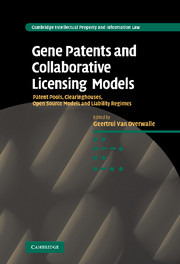 Gene Patents and Collaborative Licensing Models
Gene Patents and Collaborative Licensing Models Book contents
- Frontmatter
- Contents
- List of contributors
- Preface
- Foreword: Jean-Jacques Cassiman
- List of abbreviations
- Part I Patent pools
- Part II Clearinghouses
- Part III Open source models
- Part IV Liability regimes
- Part V Different perspectives
- Part VI Summary and concluding analysis
- 25 Of thickets, blocks and gaps. Designing tools to resolve obstacles in the gene patents landscape
- Index
- Titles in the series
25 - Of thickets, blocks and gaps. Designing tools to resolve obstacles in the gene patents landscape
from Part VI - Summary and concluding analysis
Published online by Cambridge University Press: 14 January 2010
- Frontmatter
- Contents
- List of contributors
- Preface
- Foreword: Jean-Jacques Cassiman
- List of abbreviations
- Part I Patent pools
- Part II Clearinghouses
- Part III Open source models
- Part IV Liability regimes
- Part V Different perspectives
- Part VI Summary and concluding analysis
- 25 Of thickets, blocks and gaps. Designing tools to resolve obstacles in the gene patents landscape
- Index
- Titles in the series
Summary
Introduction
Human genes have been the subject of patent protection for quite some time. It has become common practice to grant patents for genes isolated from the human body, meeting the conditions of novelty, inventive step and industrial applicability. Even though the initial wave of criticism against human gene patents has quieted down, the controversy lingers on as the current patent landscape for human genomic science gives rise to new concerns.
Objections have especially been raised with regard to the exploitation and licensing of gene patents. Mixing metaphors, thoughtful observers are increasingly expressing concerns that the exponential growth of patents claiming human DNA sequences may lead to a ‘patent thicket’ or even a ‘patent tsunami’. It is feared that an abundance of patents will lead to royalty stacking and ultimately frustrate the use of technology, leading to a ‘tragedy of the anticommons’ in upstream research. An anticommons effect may not only arise from the emergence of patent thickets, but also from ‘blocking patents’. Concerns have equally been expressed with regard to downstream research in the genetic field. New inventions might not find their way into products and a ‘translational gap’ might widen to form a ‘valley of death’.
The authors in the present collection have reflected on the impact of gene patents and have explored various measures to deal with possible hindering effects, each in their own way and from their own, theoretical or practical, experience. Their papers form the very basis of this book.
- Type
- Chapter
- Information
- Gene Patents and Collaborative Licensing ModelsPatent Pools, Clearinghouses, Open Source Models and Liability Regimes, pp. 383 - 464Publisher: Cambridge University PressPrint publication year: 2009
- 2
- Cited by


